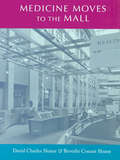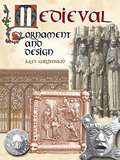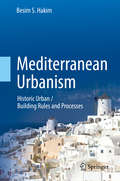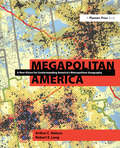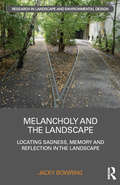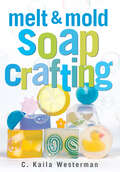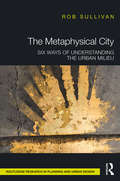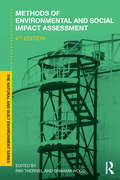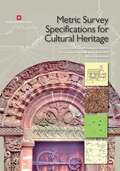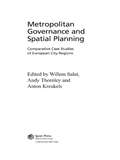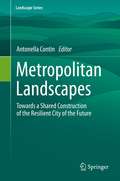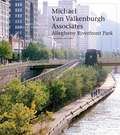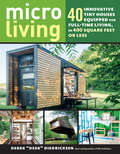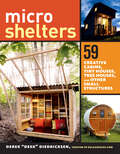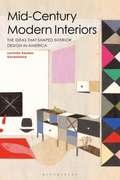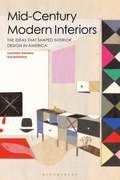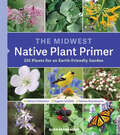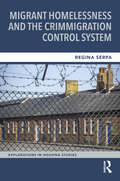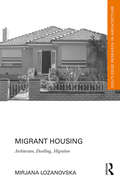- Table View
- List View
Medicine Moves to the Mall (Center Books on Space, Place, and Time)
by David Charles Sloane Beverlie Conant SloaneThe shopping mall seems an unlikely place to go for health care services. Yet, the mall has become home to such services as well as a model for redesigning other health care facilities. In Medicine Moves to the Mall, David Charles Sloane and Beverlie Conant Sloane document the historical changes to our health care landscape by exploring the interactions between medicine and place. This unique combination of architectural history and the history of medicine provides a thought-provoking analysis of the geography of the practice of medicine.The book presents three essays, each accompanied by a gallery of historical and recent photos. The authors discuss the rise of modern hospitals and how they were shaped into scientifically sterile and humanly stark "medical workshops." Starting in the 1970s, hospital facilities were altered in appearance to become more friendly and welcoming. The integration of a shopping mall's spaciousness and open design with technology and scientific innovation served in "humanizing the hospital." Most recently, the accessibility and convenience of shopping center and roadside clinics have invited Americans to go "shopping for health" in the increasingly commercialized medical system.Medicine Moves to the Mall will appeal to scholars and professionals in fields ranging from health care to cultural geography and from urban studies to architectural history, as well as to readers interested in the shifting status of medicine in American society.
Medieval Ornament and Design
by Jules GailhabaudThis lavish archive of exquisite engravings and designs--originally created in the mid-nineteenth century for the professional artist and architect--contains some 200 splendid illustrations, expertly adapted from decorative as well as utilitarian features of medieval cathedrals, churches, tombs, houses, shops, public buildings, and other structures. Encompassing a wide variety of styles, the designs include finely detailed panels, gawking gargoyles, marvelously carved pillars and pedestals, exquisite ironwork patterns, decorative stonework, magnificent stained glass windows, moldings enhanced with intricately woven motifs, and much more.Artists, designers, and craftworkers will find wide use for these versatile, royalty-free illustrations. Students of architecture, art historians, and lovers of ornamental art will delight in the pure beauty of this magnificent collection.
Mediterranean Urbanism: Historic Urban / Building Rules and Processes
by Besim S. HakimThis book brings together historic urban / building rules and codes for the geographic areas including Greece, Italy and Spain. The author achieved his ambitious goal of finding pertinent rules and codes that were followed in previous societies for the processes that formed the built environment of their towns and cities, including building activities at the neighborhood level and the decision-making process that took place between proximate neighbors. The original languages of the texts that were translated into English are Greek, Latin, Italian, Arabic and Spanish. The sources for the chapter on Greece date from the 2nd century B.C.E. to the 19th century C.E. Those for the chapter on Italy date from the 10th to the 14th centuries C.E. and for the chapter on Spain from the 5th to the 18th centuries C.E. Numerous appendices are included to enhance and elaborate on the material that make up the chapters. This book provides lessons and insights into how compact and sustainable towns and cities that are greatly admired today were achieved in the past and how we and future generations can learn from this rich heritage, including the valuable insight provided by the nature of the rules and codes and their application through centuries of continuous use.
Megapolitan America
by Robert Lang Arthur NelsonWith an expected population of 400 million by 2040, America is morphing into an economic system composed of twenty-three 'megapolitan' areas that will dominate the nation’s economy by midcentury. These 'megapolitan' areas are networks of metropolitan areas sharing common economic, landscape, social, and cultural characteristics. The rise of 'megapolitan' areas will change how America plans. For instance, in an area comparable in size to France and the low countries of the Netherlands and Belgium – considered among the world's most densely settled – America's 'megapolitan' areas are already home to more than two and a half times as many people. Indeed, with only eighteen percent of the contiguous forty-eight states’ land base, America's megapolitan areas are more densely settled than Europe as a whole or the United Kingdom. Megapolitan America goes into spectacular demographic, economic, and social detail in mapping the dramatic – and surprisingly optimistic – shifts ahead. It will be required reading for those interested in America’s future.
Megapolitan America
by Robert Lang Arthur NelsonWith an expected population of 400 million by 2040, America is morphing into an economic system composed of twenty-three 'megapolitan' areas that will dominate the nation’s economy by midcentury. These 'megapolitan' areas are networks of metropolitan areas sharing common economic, landscape, social, and cultural characteristics. The rise of 'megapolitan' areas will change how America plans. For instance, in an area comparable in size to France and the low countries of the Netherlands and Belgium – considered among the world's most densely settled – America's 'megapolitan' areas are already home to more than two and a half times as many people. Indeed, with only eighteen percent of the contiguous forty-eight states’ land base, America's megapolitan areas are more densely settled than Europe as a whole or the United Kingdom. Megapolitan America goes into spectacular demographic, economic, and social detail in mapping the dramatic – and surprisingly optimistic – shifts ahead. It will be required reading for those interested in America’s future.
Melancholy and the Landscape: Locating Sadness, Memory and Reflection in the Landscape (Routledge Research in Landscape and Environmental Design)
by Jacky BowringWritten as an advocacy of melancholy’s value as part of landscape experience, this book situates the concept within landscape’s aesthetic traditions, and reveals how it is a critical part of ethics and empathy. With a history that extends back to ancient times, melancholy has hovered at the edges of the appreciation of landscape, including the aesthetic exertions of the eighteenth-century. Implicated in the more formal categories of the Sublime and the Picturesque, melancholy captures the subtle condition of beautiful sadness. The book proposes a range of conditions which are conducive to melancholy, and presents examples from each, including: The Void, The Uncanny, Silence, Shadows and Darkness, Aura, Liminality, Fragments, Leavings, Submersion, Weathering and Patina.
Melancholy and the Landscape: Locating Sadness, Memory and Reflection in the Landscape (Routledge Research in Landscape and Environmental Design)
by Jacky BowringWritten as an advocacy of melancholy’s value as part of landscape experience, this book situates the concept within landscape’s aesthetic traditions, and reveals how it is a critical part of ethics and empathy. With a history that extends back to ancient times, melancholy has hovered at the edges of the appreciation of landscape, including the aesthetic exertions of the eighteenth-century. Implicated in the more formal categories of the Sublime and the Picturesque, melancholy captures the subtle condition of beautiful sadness. The book proposes a range of conditions which are conducive to melancholy, and presents examples from each, including: The Void, The Uncanny, Silence, Shadows and Darkness, Aura, Liminality, Fragments, Leavings, Submersion, Weathering and Patina.
Melt & Mold Soap Crafting
by C. Kaila WestermanCook colorful, whimsical, eye-catching soaps right in your microwave! It&’s easy and fun with C. Kaila Westerman&’s guide to creative soap making. Westerman&’s recipes are free of harsh chemicals and she encourages you to play with colors, scents, and shapes that the whole family will enjoy — from rubber duckies to sailboats, stars, and gemstones. With an inexpensive soap base, some food coloring, and a bit of imagination, you can quickly create handy bars for kid-friendly cleaning and hours of bath time fun.
The Metaphysical City: Six Ways of Understanding the Urban Milieu
by Rob SullivanThe Metaphysical City examines the metaphorical existence of the city as an entity to further understand its significance on urban planning and geography. It encourages an open-minded approach when studying cities so as to uncover broader connecting themes that may otherwise be missed. Case studies of New York, Paris, Cairo, Mumbai, Tokyo, and Los Angeles explore a metaphor specific to each city. This multidisciplinary analysis uses philosophical treatises, geographical analysis, and comparative literature to uncover how each city corresponds to the metaphor. As such, it allows the reader to understand the city from six differing points of view. This book would be beneficial to students and academics of urban planning, geography, and comparative literature, in particular those with an interest in a metaphysical examination of cities.
The Metaphysical City: Six Ways of Understanding the Urban Milieu
by Rob SullivanThe Metaphysical City examines the metaphorical existence of the city as an entity to further understand its significance on urban planning and geography. It encourages an open-minded approach when studying cities so as to uncover broader connecting themes that may otherwise be missed. Case studies of New York, Paris, Cairo, Mumbai, Tokyo, and Los Angeles explore a metaphor specific to each city. This multidisciplinary analysis uses philosophical treatises, geographical analysis, and comparative literature to uncover how each city corresponds to the metaphor. As such, it allows the reader to understand the city from six differing points of view. This book would be beneficial to students and academics of urban planning, geography, and comparative literature, in particular those with an interest in a metaphysical examination of cities.
Methods of Environmental and Social Impact Assessment (Natural and Built Environment Series)
by Peter Morris Riki Therivel Graham WoodEnvironmental and social impact assessment (ESIA) is an important and often obligatory part of proposing or launching any development project. Delivering a successful ESIA needs not only an understanding of the theory but also a detailed knowledge of the methods for carrying out the processes required. Riki Therivel and Graham Wood bring together the latest advice on best practice from experienced practitioners to ensure an ESIA is carried out effectively and efficiently. This new edition: • explains how an ESIA works and how it should be carried out • demonstrates the links between socio-economic, cultural, environmental and ecological systems and assessments • incorporates the World Bank’s IFC performance standards, and best practice examples from developing as well as developed countries • includes new chapters on emerging ESIA topics such as climate change, ecosystem services, cultural impacts, resource efficiency, land acquisition and involuntary resettlement. Invaluable to undergraduate and MSc students of ESIA on planning, ecology, geography and environment courses, this internationally oriented fourth edition of Methods of Environmental and Social Impact Assessment is also of great use to planners, ESIA practitioners and professionals seeking to update their skills.
Methods of Environmental and Social Impact Assessment (Natural and Built Environment Series)
by Riki Therivel and Graham WoodEnvironmental and social impact assessment (ESIA) is an important and often obligatory part of proposing or launching any development project. Delivering a successful ESIA needs not only an understanding of the theory but also a detailed knowledge of the methods for carrying out the processes required. Riki Therivel and Graham Wood bring together the latest advice on best practice from experienced practitioners to ensure an ESIA is carried out effectively and efficiently. This new edition: • explains how an ESIA works and how it should be carried out • demonstrates the links between socio-economic, cultural, environmental and ecological systems and assessments • incorporates the World Bank’s IFC performance standards, and best practice examples from developing as well as developed countries • includes new chapters on emerging ESIA topics such as climate change, ecosystem services, cultural impacts, resource efficiency, land acquisition and involuntary resettlement. Invaluable to undergraduate and MSc students of ESIA on planning, ecology, geography and environment courses, this internationally oriented fourth edition of Methods of Environmental and Social Impact Assessment is also of great use to planners, ESIA practitioners and professionals seeking to update their skills.
Metric Survey Specifications for Cultural Heritage: 3rd Edition (English Heritage)
by Paul Bryan Bill Blake John BedfordMetric survey forms an essential part of the conservation cycle and provides a valuable source of base mapping for analytical projects. In supplying metric survey data to buildings curators, conservators, architects and archaeologists, surveyors need to know what makes survey work for cultural heritage. A proven specification is a valuable tool for use in achieving this goal. Getting the right survey for the right job is important. This specification provides a guide to the user and the supplier of metric survey data. It explains the services expected and performance indicators to ensure the successful management of metric survey projects. It is a revised and updated second edition of Metric Survey Specifications for English Heritage – the standard specification that English Heritage has successfully used to procure metric survey for the last nine years. The new title reflects a more generic approach that, it is hoped, will make the specifications easier to apply across the cultural heritage profession. This edition also covers the collection of terrestrial laser-scan data, which is increasingly applicable to the survey of historic buildings and landscapes.
Metropolitan Governance and Spatial Planning: Comparative Case Studies of European City-Regions
by Anton Kreukels Willem Salet Andy ThornleyMetropolitan Governance and Spatial Planning explores the relationship between metropolitan decision-making and strategies to co-ordinate spatial policy. This relationship is examined across 20 cities of Europe and the similarities and differences analysed.Cities are having to formulate their urban policies in a very complex and turbulent environment. They are faced with numerous new pressures and problems and these often create contradictory conditions. The book provides a theoretical framework for exploring these issues and links this to a detailed investigation of each city. In the context of globalisation, cities in the last twenty years have experienced new patterns of activity and these usually transcend political boundaries. The management of these changes therefore requires an effort of co-ordination and different cities have found different approaches.However the institutional setting itself has not remained static. The nation states in Europe have handed over many responsibilities to the European Union while also increasing devolution to regions and cities. Government has therefore become a more complex multi-level activity.There has also been the move from government to governance. Many different public, quasi-public and private bodies are now involved in making decisions that affect urban development. Metropolitan governance is therefore also a complex multi-actor process.In these conditions of fragmented governance and the widening spatial networking of urban development, the issue of policy co-ordination become ever more important. The exploration of the 20 cities shows that many face similar difficulties while some also provide interesting examples of innovative practice. The book concludes that the way forward is to find strategies to link the different spheres of metropolitan action through 'organising connectivity'.
Metropolitan Governance and Spatial Planning: Comparative Case Studies of European City-Regions
by Willem Salet Andy Thornley Anton KreukelsMetropolitan Governance and Spatial Planning explores the relationship between metropolitan decision-making and strategies to co-ordinate spatial policy. This relationship is examined across 20 cities of Europe and the similarities and differences analysed.Cities are having to formulate their urban policies in a very complex and turbulent environment. They are faced with numerous new pressures and problems and these often create contradictory conditions. The book provides a theoretical framework for exploring these issues and links this to a detailed investigation of each city. In the context of globalisation, cities in the last twenty years have experienced new patterns of activity and these usually transcend political boundaries. The management of these changes therefore requires an effort of co-ordination and different cities have found different approaches.However the institutional setting itself has not remained static. The nation states in Europe have handed over many responsibilities to the European Union while also increasing devolution to regions and cities. Government has therefore become a more complex multi-level activity.There has also been the move from government to governance. Many different public, quasi-public and private bodies are now involved in making decisions that affect urban development. Metropolitan governance is therefore also a complex multi-actor process.In these conditions of fragmented governance and the widening spatial networking of urban development, the issue of policy co-ordination become ever more important. The exploration of the 20 cities shows that many face similar difficulties while some also provide interesting examples of innovative practice. The book concludes that the way forward is to find strategies to link the different spheres of metropolitan action through 'organising connectivity'.
Metropolitan Landscapes: Towards a Shared Construction of the Resilient City of the Future (Landscape Series #28)
by Antonella ContinThis edited volume covers many aspects of the Metropolitan Landscapes. Solutions are needed to meet the demand of the citizens of a renewed metropolitan region landscape. It opens up discussions about possible toolkits for strategic actions based on understanding the territory from geographical, urban, architectural, economic, environmental, and public policy perspectives. This book intends to promote the Metropolitan dwelling quality, ensuring human well-being proposing a discussion on the resilient articulation of the interface space among the city's infrastructure, agriculture, and nature.This book results from the Symposium: Metropolitan Landscapes that MSLab of the Politecnico di Milano and ETSA (Sevilla) organized at the IALE 2019 Conference (Milan, July 2019) to manage radical territory transformation with a strategic vision. The widespread growth of urban areas indicates the importance of building resilient sustainable cities capable of minimizing climate-change impact production.The Symposium aimed to discuss the Urban Metabolism approach considering the combination of Landscapes set in a single Metropolitan Ecosystem. Accordingly, new design strategies of transformation, replacement or maintenance can compose Urban-Rural Linkage patterns and a decalage of different landscape contexts. Ecological interest in environmental sustainability, compatibility, and resilience is not tied exclusively to the balance between production and energy consumption. Thus, it is the integration over time and at several scales of the urban and rural landscapes and their inhabitants that nourish the Metropolitan Bioregion.Moreover, the Metropolitan Landscape Book's research hypothesis is the need for a Glossary, strengthening the basis of understanding Metropolitan Landscape's complexity.This book's topic is particularly relevant to Landscape Urbanism, Architecture, Urban disciplines Scholars, Students and Practitioners who want to be connected in a significant way with Metropolitan Discipline’s research field.
Michael Van Valkenburgh Associates: Allegheny Riverfront Park (Source Books in Landscape Architecture #1)
by Jane AmidonIn the field of landscape architecture, there is no more distinguished voice than Michael Van Valkenburgh, and it therefore seems appropriate that we begin this new Source Books in Landscape series with his recently completed Allegheny Riverfront Park project for Pittsburgh, Pennsylvania. As part of the city’s efforts to restore its downtown district and riverfront, Van Valkenburgh, along with artists Ann Hamilton and Michael Mercil, developed an ambitious plan to reform the wasted land along the river into an urban refuge. The celebrated collaboration between landscape architect and artist produced a thoughtful, useful, and beautiful park that has successfully renewed the city’s core. Source Books in Landscape Architecture, produced in collaboration with Ohio State University, will provide detailed documentation of important new projects, following its development from conception through completion using sketches, drawings, models, renderings, working drawings, and photographs.
Micro Living: 40 Innovative Tiny Houses Equipped for Full-Time Living, in 400 Square Feet or Less
by Derek “Deek” DiedricksenLive tiny without sacrificing the comforts of home with Derek &“Deek&” Diedricksen&’s lively exploration of 40 small dwellings outfitted with features essential to full-time, year-round living — complete with floor plans, real experiences, and expert tips from tiny house residents.
Microshelters: 59 Creative Cabins, Tiny Houses, Tree Houses, and Other Small Structures
by Derek “Deek” DiedricksenDiscover how "big" tiny can be! With stunning photographs, fascinating information, and plans to build your own, Microshelters proves that small structures are not only useful, but stylish as well.
Mid-Century Modern Interiors: The Ideas that Shaped Interior Design in America
by Lucinda Kaukas HavenhandMid-Century Modern Interiors explores the history of interior design during arguably its most iconic and influential period. The 1930s to the 1960s in the United States was a key moment for interior design. It not only saw the emergence of some of interior design's most globally-important designers, it also saw the field of interior design emerge at last as a profession in its own right. Through a series of detailed case studies this book introduces the key practitioners of the period – world-renowned designers including Ray and Charles Eames, Richard Neutra, and George Nelson – and examines how they developed new approaches by applying systematic and rational principles to the creation of interior spaces. It takes us into the mind of the designer to show how they each used interior design to express their varied theoretical interests, and reveals how the principles they developed have become embodied in the way interior design is practiced today. This focus on unearthing the underlying ideas and concepts behind their designs rather than on the finished results creates a richer, more conceptual understanding of this pivotal period in modernist design history.With an extended introduction setting the case studies within the broader context of twentieth-century design and architectural history, this book provides both an introduction and an in-depth analysis for students and scholars of interior design, architecture and design history.
Mid-Century Modern Interiors: The Ideas that Shaped Interior Design in America
by Lucinda Kaukas HavenhandMid-Century Modern Interiors explores the history of interior design during arguably its most iconic and influential period. The 1930s to the 1960s in the United States was a key moment for interior design. It not only saw the emergence of some of interior design's most globally-important designers, it also saw the field of interior design emerge at last as a profession in its own right. Through a series of detailed case studies this book introduces the key practitioners of the period – world-renowned designers including Ray and Charles Eames, Richard Neutra, and George Nelson – and examines how they developed new approaches by applying systematic and rational principles to the creation of interior spaces. It takes us into the mind of the designer to show how they each used interior design to express their varied theoretical interests, and reveals how the principles they developed have become embodied in the way interior design is practiced today. This focus on unearthing the underlying ideas and concepts behind their designs rather than on the finished results creates a richer, more conceptual understanding of this pivotal period in modernist design history.With an extended introduction setting the case studies within the broader context of twentieth-century design and architectural history, this book provides both an introduction and an in-depth analysis for students and scholars of interior design, architecture and design history.
The Midwest Native Plant Primer: 225 Plants for an Earth-Friendly Garden
by Alan BranhagenMore homeowners than ever before are adding native plants to their gardens. This book shares the best plant choices for the Midwest and details how gardeners can grow them successfully.
Migrant Homelessness and the Crimmigration Control System (ISSN)
by Regina SerpaMigrant Homelessness and the Crimmigration Control System offers new insights into the drivers of homelessness following migration by unpacking the housing consequences of ‘crimmigration’ control systems in the US and the UK. The book advances ‘housing sacrifice’ as a concept to understand journeys in and out of homelessness and the coping strategies migrants employ. Undergirded by persuasive empirical research, it offers a compelling case for a ‘social citizenship’ right to housing guaranteed across social, political and civil realms of society. The book is structured around the 30 life stories of people who have migrated to the capital cities of Boston and Edinburgh from Central America and Eastern Europe. The narratives are complemented by interviews with a range of stakeholders (including frontline caseworkers, activists and policymakers). Guided by the tenets of critical realist theory, this book offers a biographical inquiry into the intersections of race, class and gender and provides insight into the everyday precarity homeless migrants face, by listening to them directly. It will be of interest to students, scholars, and policymakers across a range of fields including housing, immigration, criminology, sociology, and human geography.
Migrant Homelessness and the Crimmigration Control System (ISSN)
by Regina SerpaMigrant Homelessness and the Crimmigration Control System offers new insights into the drivers of homelessness following migration by unpacking the housing consequences of ‘crimmigration’ control systems in the US and the UK. The book advances ‘housing sacrifice’ as a concept to understand journeys in and out of homelessness and the coping strategies migrants employ. Undergirded by persuasive empirical research, it offers a compelling case for a ‘social citizenship’ right to housing guaranteed across social, political and civil realms of society. The book is structured around the 30 life stories of people who have migrated to the capital cities of Boston and Edinburgh from Central America and Eastern Europe. The narratives are complemented by interviews with a range of stakeholders (including frontline caseworkers, activists and policymakers). Guided by the tenets of critical realist theory, this book offers a biographical inquiry into the intersections of race, class and gender and provides insight into the everyday precarity homeless migrants face, by listening to them directly. It will be of interest to students, scholars, and policymakers across a range of fields including housing, immigration, criminology, sociology, and human geography.
Migrant Housing: Architecture, Dwelling, Migration (Routledge Research in Architecture)
by Mirjana LozanovskaMigrant Housing, the latest book by author Mirjana Lozanovska, examines the house as the architectural construct in the processes of migration. Housing is pivotal to any migration story, with studies showing that migrant participation in the adaptation or building of houses provides symbolic materiality of belonging and the platform for agency and productivity in the broader context of the immigrant city. Migration also disrupts the cohesion of everyday dwelling and homeland integral to housing, and the book examines this displacement of dwelling and its effect on migrant housing. This timely volume investigates the poetic and political resonance between migration and architecture, challenging the idea of the ‘house’ as a singular theoretical construct. Divided into three parts, Histories and theories of post-war migrant housing, House/home and Mapping migrant spaces of home, it draws on data studies from Australia and Macedonia, with literature from Canada, Sweden and Germany, to uncover the effects of unprivileged post-war migration in the late twentieth century on the house as architectural and normative model, and from this perspective negotiates the disciplinary boundaries of architecture.
